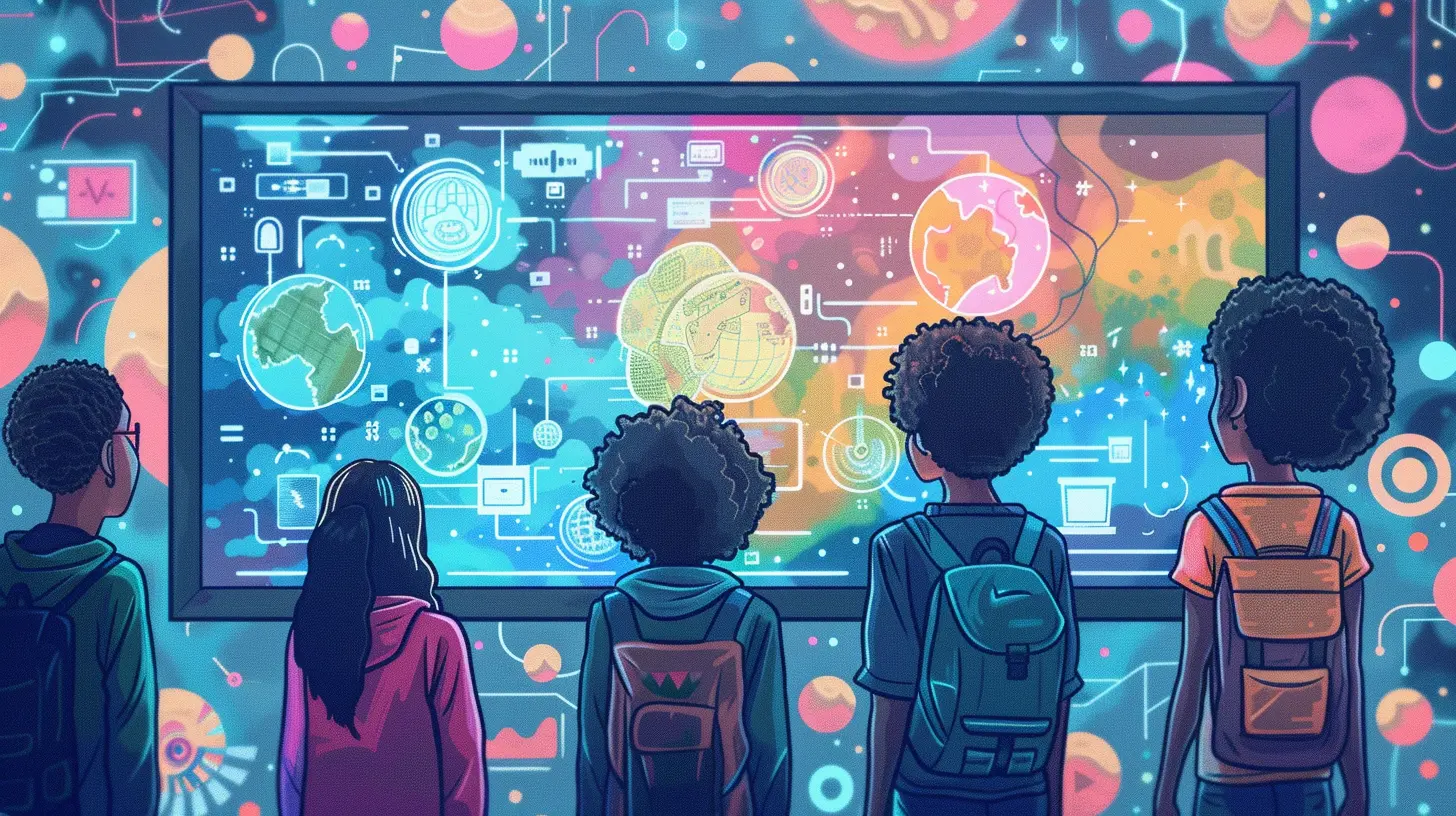Using Technology to Support Collaborative Problem Solving
1 July 2025
Ever faced a problem so complex that you needed a little help (or a lot) to solve it? Imagine trying to assemble a 5,000-piece puzzle without a picture on the box. Tough, right? Now imagine doing it while your friends are helping—each from different places, looking at pieces from different angles, and communicating in real time. That’s collaborative problem solving in a nutshell. And in today’s digital age, technology is the glue that makes the whole thing stick.
In this article, we're unpacking how technology is transforming the way people approach problems together. Whether you're in a classroom or a corporate meeting room, the tools at our fingertips are making teamwork not just easier but a whole lot smarter.
What is Collaborative Problem Solving Anyway?
Let’s break it down. Collaborative problem solving (CPS) is the process where a group of people tackles a challenge together—bringing their individual skills, experiences, and ideas to the table. Think of it like combining superheroes with different powers to save the day. Each person contributes something unique.Now, mix in technology, and suddenly, those superheroes can fly faster, talk across galaxies, and store infinite amounts of knowledge in their suits. Pretty cool, right?
Why Collaborative Problem Solving Matters (A Lot)
Before we dive into the techy stuff, let’s zoom in on why we need CPS in the first place.- Better Ideas: Two heads are better than one, and five are usually better than two. Group collaboration often leads to more innovative solutions.
- Real-World Skills: CPS helps build skills like communication, empathy, negotiation, and delegation. These are gold in both schools and workplaces.
- Efficient Problem-Solving: With everyone pitching in, problems get solved faster—and often better.
In a world that’s becoming more complex by the minute, having a team mindset is more important than ever. And that’s where technology steps into the spotlight.
How Technology Enhances Collaborative Problem Solving
Let’s not kid ourselves: teamwork isn't always easy. Miscommunication, lack of engagement, and messy logistics can quickly derail any team effort. This is where technology sweeps in like a trusty sidekick, helping everything run smoother. Here's how:1. Breaking Down Geographic Barriers
Remember snow days when everything shut down? Not anymore. Tools like Zoom, Microsoft Teams, and Google Meet mean teams can collaborate from anywhere—bedroom, beach, or boardroom.This remote access opens up multicultural, global collaboration that brings fresh perspectives into problem-solving. A student in India can work with a peer in Canada on the same science project, in real-time, thanks to tech.
2. Real-Time Communication and Feedback
Gone are the days of waiting for email replies. Chat tools like Slack, Discord, and Google Chat let ideas flow instantly. This constant back-and-forth keeps teams in sync, reduces misunderstandings, and helps everyone stay on the same page.Plus, the use of emojis, reactions, and GIFs makes communication a bit more human and a whole lot more fun.
3. Shared Digital Workspaces
Tools like Google Docs, Trello, Miro, and Notion create shared spaces where teams can brainstorm, plan, and execute—together. Google Docs even shows edits in real-time, so no more "Who changed my paragraph?!" drama.Imagine an online whiteboard that the whole team can scribble on at once. That’s digital collaboration at its finest.
4. Project Management Made Simple
Ever tried managing a group project without a plan? It’s like herding cats.With project management tools like ClickUp, Monday.com, or Asana, teams can assign tasks, set deadlines, and track progress without breaking a sweat. These tools keep everyone accountable and the project running on track.
5. AI-Powered Support
Artificial intelligence is stepping up its game in group settings. Whether it’s suggesting solutions, summarizing discussions, or analyzing group dynamics, AI tools are elevating collaborative problem-solving to the next level.Take tools like ChatGPT or Grammarly—they not only help with writing but can also assist in brainstorming ideas, refining solutions, and even predicting project outcomes.
Technology in Education: A Game-Changer for CPS
Now, let’s zoom in on how tech is transforming classrooms.1. Collaborative Learning Platforms
LMS (Learning Management Systems) like Google Classroom, Moodle, and Canvas promote teamwork by offering forums, shared docs, and group assignments. Students aren’t just learning content—they’re learning how to solve problems together.EdTech platforms like Edmodo and Flipgrid even allow students to record video responses and engage in discussions asynchronously.
2. Gamification and Problem-Based Learning
Ever solved a problem in a game without even realizing it? Platforms like Minecraft: Education Edition and Kahoot turn learning into a team sport. They make learning fun, interactive, and yes—collaborative.Problem-based learning environments powered by these tools challenge students to think critically and work together to "win" by solving real-world issues.
3. Virtual Reality and Simulations
VR and simulations take things even further. Imagine students stepping into a virtual environment to solve a science mystery or conduct a biology experiment. They can interact, test hypotheses, and learn collaboratively—all in a safe, immersive setting.Collaborative Problem Solving at Work
In the workplace, CPS is the heartbeat of innovation. And tech is the pacemaker.1. Cross-Functional Teamwork
Different departments often come together to launch new products or solve crises. With collaborative software like Airtable or Confluence, these cross-functional teams can align their thoughts and resources effortlessly.2. Cloud Computing for Seamless Access
Cloud storage tools like Google Drive or Dropbox mean everyone’s working on the latest version of a file. Say goodbye to 37 email threads with poorly named attachments like "Final_Draft_REV5_ACTUAL_FINAL_THIS_ONE.docx."3. Innovation Platforms
Many companies now use platforms like IdeaScale or Brightidea to crowdsource solutions from employees. It’s like a digital suggestion box—but smarter.These platforms encourage everyone to contribute ideas, vote on the best ones, and collaborate to refine them into real solutions.
Challenges and Pitfalls
Let’s keep it real. As awesome as tech is, it's not always a magic bullet.Tech Overload
Using too many tools can be overwhelming. One minute you’re checking Trello, the next you’re lost in Slack notifications, then you’ve got a Zoom invite, and... wait, what were we solving again?The key? Choosing the right tools for the task—and sticking to them.
Lack of Digital Skills
Not everyone is a tech wizard. It’s crucial to provide proper training so every team member can confidently use the tools. Tech should empower, not intimidate.Communication Gaps
Tone doesn’t always translate well over text. That’s why combining text with video or voice chats can make communication clearer and more human.Tips for Using Technology Effectively in CPS
Okay, so how do you actually make the most of tech when solving problems as a team? Here are some bulletproof tips:- Set Clear Roles: Use tools to assign tasks so everyone knows who’s doing what.
- Use a Central Communication Hub: Don’t scatter your conversations across five apps. Choose one and stick with it.
- Keep It Human: Use video calls and voice messages to maintain a personal connection.
- Establish Ground Rules: Decide as a group how often you'll meet, how you'll resolve conflicts, and which tools you'll use.
- Embrace Feedback Loops: Use surveys or retrospectives to evaluate how well the team’s using the tech and collaborating.
The Future of Collaborative Problem Solving
With advances in artificial intelligence, machine learning, and even virtual reality, collaborative problem solving is poised to become even more dynamic. We're moving toward environments where teams can work in virtual rooms, assisted by AI mentors, using data-driven insights to guide their decisions.Heck, we might even see collaboration between human and AI teams in the future. And isn’t that a sci-fi story come true?
Final Thoughts
Technology isn’t just a helper in collaborative problem solving—it’s the amplifier. It takes what we can do together and scales it. Whether you’re a student working on a project, a teacher guiding a class, or a manager leading a team, the right tech can turn brainstorming into brilliance—and chaos into clarity.So next time you're facing a problem that feels way too big to tackle alone, remember: you've got tools, you've got teammates, and with a little tech magic, you’ve got this.
all images in this post were generated using AI tools
Category:
Problem SolvingAuthor:

Anita Harmon
Discussion
rate this article
1 comments
Darrow Ward
Because talking is overrated!
July 25, 2025 at 4:14 AM

Anita Harmon
While talking has its merits, technology can enhance collaboration by providing diverse tools for engagement and problem-solving.


